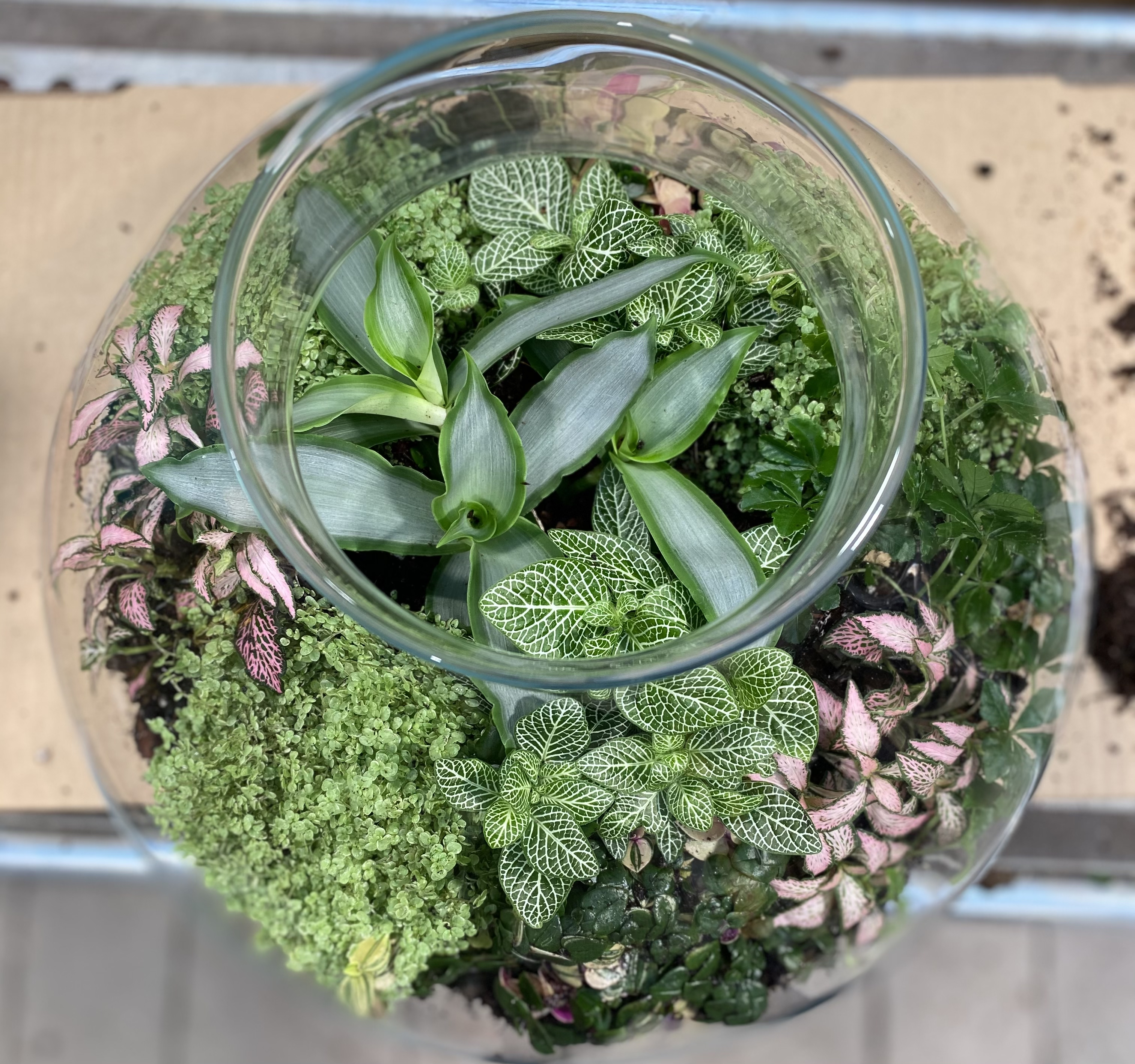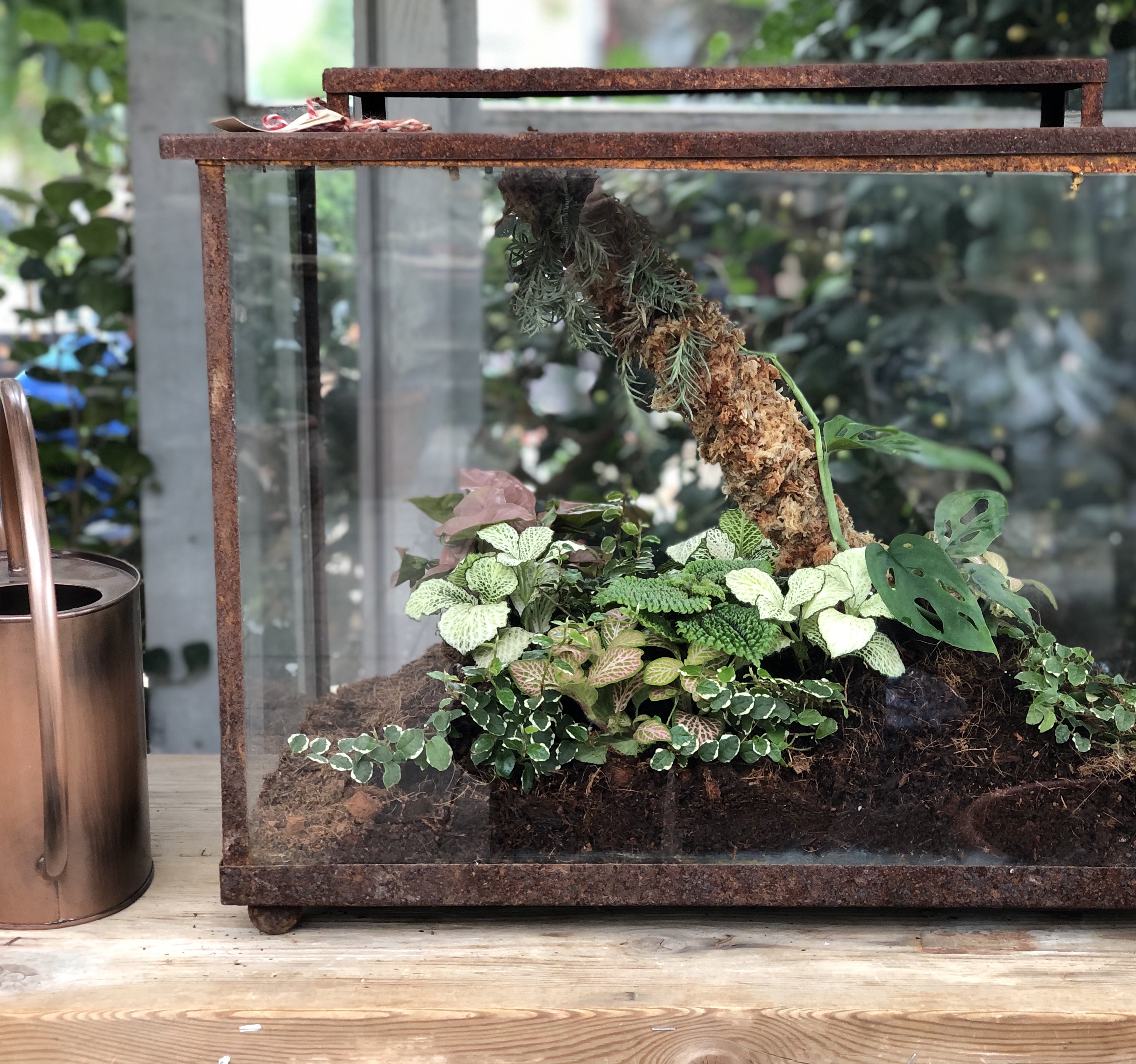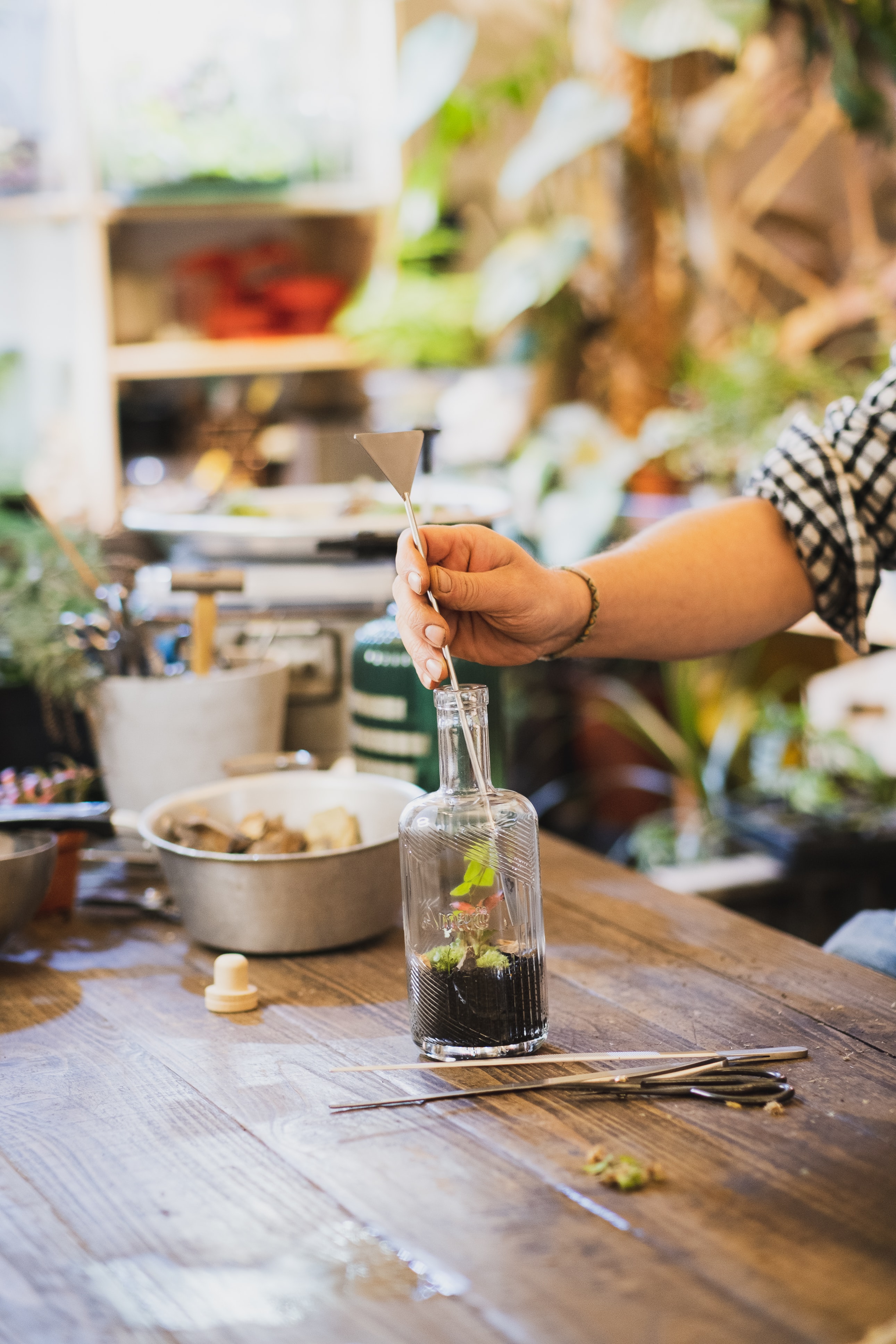What is an open terrarium?
An open terrarium is a fun and easy way to grow, decorate and be creative with plants.
An open terrarium may not fit the textbook definition for a terrarium, but it has many of the same traits. Essentially it's a partially open vessel that contains more humidity while still allowing air to flow freely. These lack drainage holes and will need a false bottom or well draining soil to prevent overwatering issues. Compared to a closed terrarium, which becomes its own self sustaining ecosystem, the open terrarium will need more upkeep such as regular watering, misting and pruning. However, it will be more versatile and suit a wider range of plants instead.

This terrarium contains Fittonia 'Forrest Flame' and 'White Angel', Soleirolia soleirolii, Callisia repens 'Bianca' , Murdannia 'Bright Star' and Clematicissus striata
Care
Lighting is the most crucial part when it comes to caring for your terrarium. It needs plenty of bright but only indirect light to be able to thrive. If your planter is exposed to direct sunlight it can become over heated and even cook the plants inside. But if you place your terrarium in an area that's too dark , your plants won't be able to perform photosynthesis properly. It can cause the plants to grow very sparse and weak (called etiolated) which could even be fatal to the plants.
A spot where it'll be able to "see" the sky, but is protected from direct sun light, is the best spot. If you live in a climate with less day hours during any season you might want to either move your planter to a brighter spot or supply it with grow lights during the darker season.
- Rotating your planter regularly is a good idea to maintain a more thriving ecosystem if the light direction is only exposing one side of the vessel.
Water your planter so it's kept evenly moist but not wet. You don't want water to build up, making the soil water logged. This can be fatal to your plants and also cause a rotten smell.
Misting your planter regularly will be beneficial to your tropical plants. Depending on how open the planter is you might need to mist it more or less often.
We recommend that you fertilize your planter sparingly to avoid too much nutrients building up in the planter. Follow the tasks in Planta and your terrarium will thrive!

This terrarium contains Fittonia 'White Star' and 'Mistral Pink', Synonym podophyllum 'Neon', Monstera adansonii, Ficus pumila 'White Sunny', Pilea involucrata 'Moon Valley' and Tillandsia capillaris
Want to create your own open terrarium?
Then this is all you need
A vessel or planter
Drainage layer
Soil
Suitable plants
Air tight vessel
You can choose any shape or type of vessel as long as it's see through so the plants are able to perform photosynthesis. We recommend using one made out of glass as it's more durable, won't get discolored, doesn't age and doesn't get scratched as easily as a plastic containers. Mason jars, bottles, lanterns, serving bowls or even fish bowls can be used. Be creative and search through your home or a nearby thrift shop. There are also a lot of bottles available in garden centers that are made for just this type of project.
Drainage layer
The drainage layer needs to be made out of minerals so it doesn't decompose. LECA, pumice, coarse sand and decorative gravels are just some examples that are suitable as a drainage layer. Adding a drainage layer will help your plants thrive and prevent watering issues. If you're vessel of choice doesn't have that much space you can skip this part and try to make the soil more draining instead. But we recommend adding one if possible.
Soil
A light, fertile and fluffy soil type is suitable when planting your terrarium. Regular all purpose potting soil or a more tropical soil mix with coco coir and chunks of bark and perlite works as well.
Suitable plants
Since you're creating a tropical environment it's important that you choose tropical plants . Succulents and cacti won't do well in your humid planter. Also choosing plants that won't grow grow too large is advised.
Trees and shrubs with woody stems can be risky to use, both due to their larger growth habits, but also because they're prone to get stem rot if planted in humid environments.
We recommend that you choose a mix of a ground covering plants , a taller plant and a color popping plant . Try to choose plants that contrast with each others to make the planter interesting and eye-catching.
- We will list suitable plants further down in this article if you need some inspiration.

This terrarium contains Soleirolia soleirolii and Pteris ensiformis
How to create your terrarium
1. Start by adding a drainage layer at the bottom of the vessel. A layer of at least ½ in (1cm) if possible. If the vessel you use is big and has space lots of space, you can increase the drainage layer. Try to keep it to 1/3 third of the total thickness of the bottom substrates.
- Optional: If you want to make it more advanced you can add a substrate divider to prevent the soil from blending into the drainage layer. A durable thin mesh, screen or even sphagnum moss can be used as such.
2. Add the soil of your choice and spread it out evenly on top of the drainage layer. If you have a larger vessel you can try to create a slope or make the center higher for to create a more interesting design. Make sure it'll have space for the roots of your plants.
- Optional: You can also add rocks, wood, figurines, sea shells or other objects to decorate the terrarium with. Some will also be excellent to use as support for climbing or epiphytic plants.
3. Now it's time for the plants! We recommend starting with the outer plants first and then working your way to the center of your creation, especially if you're working with a vessel that has a tighter neck such as a bottle.
Remove most of the old soil from the roots of the plants. Lots of plants can be divided or may have several plants in the same pot. Divide them to help spread them out more. You don't need to fill out all the free space as the plants will grow.
4. Finish up the planter by cleaning the inside walls of the vessel and brushing off dirt from the plants. Water the plants by misting them with a spray bottle. This can also help clean off the remaining dirt from the plants and the walls of the vessel. When the plants are watered enough and it's clean you're finally done! Now you just need to find the perfect spot for it to live.
- Note that it's perfectly normal for small microorganisms to thrive in your planter. Spring tails and wood lice is not uncommon to have in your terrarium. They are totally harmless and nothing to worry about.
5. You can add your open terrarium to your Planta account to get tasks and to follow its progress

Suitable plants
- "sp." meaning there are multiple suitable plants within that genus.
Low growing and ground covering plants
Ficus pumila, Creeping fig
Pilea libanensis, Silver sprinkles
Callisia repens, Turtle vine
Soleirolia soleirolii, Baby tears
Selaginella kraussiana, Krauss' spikemoss
Pilea depressa , Giant's baby's tears
Peperomia prostrata, String of turtles
Different types of tropical mosses
Ferns to add texture
Adiantum sp.
Nephrolepis sp.
Pteris sp.
Asplenium sp.
Phlebodium sp.
Microsorum sp.
Doryopteris sp.
Asparagus sp.
Selaginella sp. - Not a fern but a spikemoss and adds similar texture to the mix
Hemionitis cordata , Heart leaf fern
Pellaea rotundifolia, Button fern
Davallia sp.
Actiniopteris australis , Eyelash fern
Medium sized plants to add interesting foliage and color
Fittonia sp., Nerve plant
Syngonium podophyllum, Arrowhead plant
Epipremnum aureum, Pothos
Philodendron hederaceum, Heart leaf philodendron
Alocasia sp. - Choose smaller sized species and cultivars such as 'Bambino', 'Black Velvet' and Alocasia maharani
Peperomia sp.
Begonia sp.
Macodes petola, Lighting bolt jewel orchid
Ludisia discolor, Jewel orchid
Hypoestes polystaycha, Polka dot plant
Tradescantia sp.
Clorophytum comosum, Spider plant
Pilea sp.
Muehlenbeckia sp.
Pellonia repens, Trailing watermelon begonia
Gynura aurantiaca , Purple passion
Aglaonema sp.
Maranta leuconeura, Prayer plant
Philodendron sp.
Monstera sp.
Goeppertia sp. (Formerly known as Calathea )
Anthurium sp.
Callisia sp.
Synognium sp.
Murdannia ioriformis,
Rhaphidophora sp.
Nidularium sp.
Cercestis mirabilis, African embossed cercestis
Cissus amazonica, Amazon jungle vine
Episcia sp.
Ficus punctata
Ficus scandens